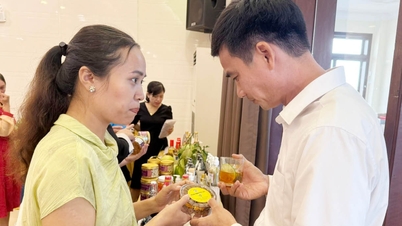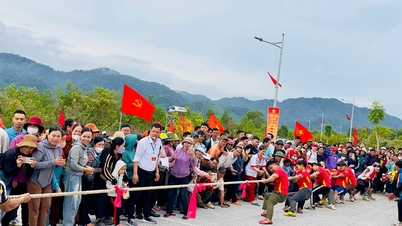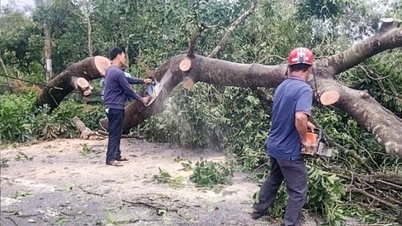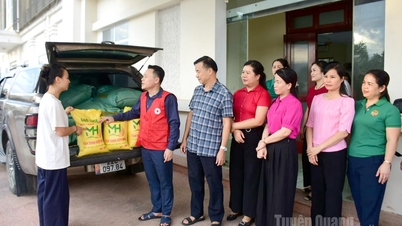Currently, the weather is changing erratically, alternating sunshine and rain, cloudy weather, fog, drizzle, high humidity, temperature from 22-260 C... are good conditions for pests to arise, develop and cause damage to crops, of which the most harmful is rice.

Pest control in winter-spring rice crop - Photo: TCL
Currently, rice is in the tillering stage, which is a very important stage that determines productivity, so farmers need to strengthen care measures and promptly detect harmful pests and diseases to quickly handle them, avoiding affecting the effective tillering of rice.
In the 2023-2024 winter-spring crop, the whole province planted more than 25,500 hectares of rice. Thanks to favorable weather at the beginning of the season and farmers implementing intensive farming measures well, the rice plants grew well. However, currently, pests are emerging and developing strongly in the fields such as: rats causing damage on an area of 455 hectares, with a common damage rate of 5% - 10%; rice blast disease causing damage on an area of 102 hectares, with a common damage rate of 7% - 10%...
The disease is harmful in many areas with old outbreaks; on rice fields with excess nitrogen fertilizer and lack of potassium; on rice varieties susceptible to blast disease such as: Bac Thom 7, IR38, HC95, BDR57, VN10... Localities with a lot of rice affected by blast disease include: Cam Lo district, Gio Linh, Dong Ha city...
In order to proactively prevent and control pests and diseases on crops early to bring high efficiency, the Department of Agriculture and Rural Development directs specialized units under the department to synchronously deploy measures to prevent and control pests and diseases on crops.
At the same time, coordinate with districts, towns and cities to direct specialized units and localities to coordinate with crop and plant protection stations and agricultural extension stations to strengthen field inspections and guide farmers on technical measures to care for and prevent plant pests and diseases.
Rice blast is a disease caused by the fungus Pyricularia Oryzae, which causes damage throughout the growth of rice plants, often causing leaf burn at the tillering and panicle initiation stages and damaging the panicle neck at the flowering stage, seriously affecting rice yield. The disease appears most often during the period of intensive tillering, flowering and grain filling.
Blast disease appears on leaves initially as very small spots (as small as a needle) surrounded by a yellow halo, the center of the lesion is light gray, then turns dark brown and spreads into a diamond shape with an ash gray center.
If the disease is severe, the lesions will connect to form large patches, causing the leaves to burn and the plant to die. Blast disease appears on the stem, the neck of the flower and the neck of the ear, initially as a small gray spot that later turns brown and spreads around the stem, the neck of the flower and the neck of the ear. When this fungus severely infects the rice plant, the nutrient vessels on the rice plant are cut off, causing the entire rice flower to lack nutrients, leading to the rice not being able to grow firmly, causing it to be flat. Severe disease will cause total loss of yield. Blast disease also appears on the grain, initially as round brown spots on the husk, then the fungus infects the grain, causing the rice grain to turn black and flat.
To effectively prevent blast disease, farmers need to use disease-resistant varieties right from the seed selection. For fields with old outbreaks, the soil needs to be carefully prepared. During the care process, it is necessary to apply balanced fertilizer, heavy at the beginning and light at the end, avoid sporadic and scattered fertilizers at the end of the crop, increase the application of decomposed manure, phosphate fertilizer, and potassium fertilizer to increase resistance and improve productivity, avoid excessive nitrogen fertilizer, and water adequately and reasonably.
Strengthen inspection of blast disease on all varieties, carefully check on susceptible varieties, on densely sown fields, with excess nitrogen fertilization... to have timely management measures. On fields with blast disease, it is necessary to immediately stop applying nitrogen fertilizer and foliar fertilizer, increase the water level in the field, urgently spray disease prevention drugs such as Beam, Fillia, Flash, Map Famy, Fuji - one... according to the recommended dosage, need to spray thoroughly on leaves and stems, spray in the cool afternoon, the amount of water and medicine mixed is 20 liters/package/sao, heavily affected areas must be sprayed twice, 5-7 days apart.
For rice fields that have been infected with leaf blast disease, it is necessary to spray to prevent neck blast disease 5-7 days before and after the rice heads, and it is advisable to change the pesticide between sprays. For rice fields that have been infected with rice blast disease, after spraying, the disease should stop developing before being fertilized again. In addition, it is necessary to pay attention to the development of other pests such as: various types of planthoppers, small leaf rollers, spider mites, bacterial leaf blight... to have timely prevention measures.
To prevent harmful rats, it is necessary to kill rats by manual methods such as digging and catching, using traps combined with biological drugs; absolutely do not use electric shock to kill rats to ensure safety for people and other animals in the fields.
If pests and diseases on rice plants, especially blast disease, are not prevented early and effectively, it is very easy to seriously affect rice productivity. Therefore, farmers need to regularly visit fields, detect pests and diseases early and promptly implement effective prevention measures for successful production in the 2023-2024 winter-spring crop.
Tran Cat Linh
Source



![[Photo] President of the Cuban National Assembly visits President Ho Chi Minh's Mausoleum](https://vphoto.vietnam.vn/thumb/1200x675/vietnam/resource/IMAGE/2025/10/1/39f1142310fc4dae9e3de4fcc9ac2ed0)



![[Photo] Hanoi morning of October 1: Prolonged flooding, people wade to work](https://vphoto.vietnam.vn/thumb/1200x675/vietnam/resource/IMAGE/2025/10/1/189be28938e3493fa26b2938efa2059e)





















































































Comment (0)